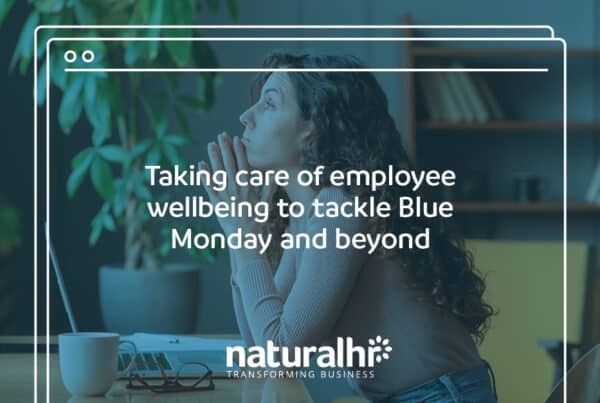
Research by mental health charity, Mind found that 60% of employees say they’d feel further motivated and more likely to recommend their organisation as a good place to work if their employer took action to support their health and wellbeing in the workplace.
Employee wellbeing describes both the physical and mental states of your team while they are at work. Physical wellbeing in the workplace could involve the temperature in the office, the ergonomics of their chair or their activity level. Mental wellbeing supports issues like stress, depression or anxiety.
Given the amount of time employees spend at work, it is important for you as their employer to ensure the workplace is conducive to happy, healthy employees.
Employee wellbeing is directly linked to employee engagement and productivity levels. Research has shown that happy and healthy employees are more productive and valuable to your business overall.
Below, you’ll find 14 of the simplest ways you can support the health and wellbeing of your employees in the workplace.
Promote balance
Research has shown that employees that regularly multi-task become less productive over time. From checking emails to answering calls; jumping from task to task lends itself to a loss of focus and frequent dips in concentration. Encourage your employees to handle one task at a time.
Create a productive environment
We all work better in a space that is designed with productivity in mind. Good lighting can prevent fatigue, eye strain and headaches while using an inspiring colour palette for your office’s décor can stimulate brain function.
Encourage creativity
Open, shared workspaces are a breeding ground for creativity. Design your larger office areas with collaboration in mind. Plentiful seating and large tables will allow your team to get together and get their creative juices flowing.
Provide an EAP
Employee Assistance Programs (EAP) provide a platform for your employees to interact with qualified professionals and seek advice on most issues that impact their health and wellbeing. From personal problems and mental health support to work-related problems; EAPs are intended to help employees to deal with any issues that may adversely impact their work performance and overall health and wellbeing.
Get comfy
The ergonomics of our working environment can play a huge role in ensuring employees’ physical wellbeing. Take the time to make sure employee workstations are ergonomically friendly, comfortable and in good condition. Good ergonomics will prevent the occurrence of injury or damage to your employees’ physical health.
Match your environment to your culture
Your office environment and your culture should be in reflection of one another’s harmony. If you’re promoting a culture of fun, energy and teamwork, but your office is a sterile boiler room environment with little to no personality at all – this disconnect will be felt by your employees.
Create a proper break room
Having a dedicated space for your employees to relax and recharge during their breaks at work is key to health and wellbeing. Not only will they get a deserved break from their desks, but break rooms provide a space for your employees to socialise with their colleagues. They’ll return from their break feeling revitalised and ready to tackle the afternoon’s tasks.
Encourage work/life balance
We’re all guilty of working late and checking our emails on the weekend. But if you are giving your employees the impression that this kind of behaviour is expected; it is guaranteed that your employees will feel more stressed and as a result, more unhappy. Encourage your employees to use their time away from the office to recharge and relax.
Give frequent recognition
A large portion of our lives is spent at work, and it is important that employees are appreciated and recognised. Whether you deliver praise in public in front of their peers or in private, recognising your employees for their contributions to your business is core to a feeling of being valued in your business. Without it, you run the risk of employees becoming disengaged.
Explore your data
Your people data holds some powerful insights into the health and wellbeing of your employees. Find out if certain teams are disengaged or which offices have the highest levels of employee satisfaction. With this data, you can effectively make changes or enhancements to ensure all of your people’s health and wellbeing needs are being met.
Let the light in
Something as simple as upgrading your lighting in the office can make a huge difference to employee productivity. Research by the World Green Building Council has shown that exposure to natural light increases productivity by 18% and better lighting in general increases work rates by a staggering 23%.
Provide healthy food options
It can be very easy for employees to nip out to the nearest fast-food restaurant for lunch which can make them feel lethargic in the afternoon. Whether you have an office canteen or not, it is simple to swap unhealthy choices for healthier alternatives. This can be as simple as making a selection of fresh fruit available for snacks or changing up your canteen’s menu to include nutritious meal choices.
Ask your employees what they need
Make a point of regularly involving your employees in developing your health and wellbeing strategies. Find out if there is anything that could be changed, improved or introduced to better support their health and wellbeing at work. They may come up with some great initiatives that you hadn’t even thought of!
Schedule social events
Frequent social activities encourage your team to develop deep friendships with their colleagues. Whether it’s drinks after work or a walk at lunchtime, encouraging your employees to spend time together will do wonders for their wellbeing. Emotional wellness at work is just as important as physical wellness; social events can really help to improve employee engagement.






